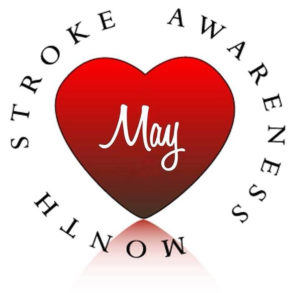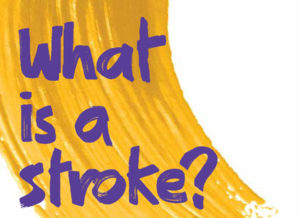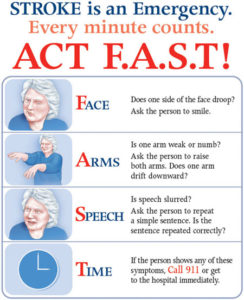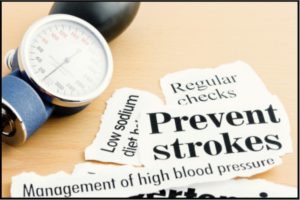 May is National Stroke Awareness Month. Every year, more than 795,000 people in the U.S. have a stroke. Someone in the U.S. has a stroke every 40 seconds and every 4 minutes, someone dies of stroke. It is the 4th leading cause of death in St. Mary’s County.
May is National Stroke Awareness Month. Every year, more than 795,000 people in the U.S. have a stroke. Someone in the U.S. has a stroke every 40 seconds and every 4 minutes, someone dies of stroke. It is the 4th leading cause of death in St. Mary’s County.
What happens during a stroke?
To work properly, the brain needs oxygen. Although the brain makes up only 2% of  your body weight, it uses 20% of the oxygen you breathe. A stroke occurs when something happens to block the flow of blood to the brain, depriving oxygen to the brain.
your body weight, it uses 20% of the oxygen you breathe. A stroke occurs when something happens to block the flow of blood to the brain, depriving oxygen to the brain.
Stroke is a leading cause of serious long-term disability, reducing mobility in more than half of stroke survivors age 65 and over. Including the cost of health care services, medicines to treat strokes, and missed days of work, strokes cost the U.S. an estimated $33 billion each year.
What is your risk of stroke?
Anyone can have a stroke at any age, but age increases your chances for a stroke. The older you are, the more likely you are to have a stroke. But certain things can increase your chances of having a stroke. While you can’t control your age or family history, you can take steps to lower your chances of having a stroke.
What can I do to prevent a stroke?
Stroke is preventable! Up to 80% of strokes could be prevented through healthy lifestyle changes and working with your health care team to control conditions that raise your risk for stroke.
These healthy lifestyle choices can help lower your risk of a stroke:
- Healthy Diet: Be sure to eat plenty of fresh fruits and vegetables. Eating foods low in saturated fats, trans fats, and cholesterol, and high in fiber can help prevent high cholesterol. Limiting salt (sodium) in your diet can also lower your blood pressure.
- Healthy Weight: Being overweight or obese increases your risk for stroke. To determine whether your weight is in a healthy range, you can calculate your body mass index (BMI), you can use the CDC’s BMI calculator.
- Physical Activity: Physical activity can help you stay at a healthy weight and lower your cholesterol and blood pressure levels. It is recommended that adults get at least 2 ½ hours of moderate-intensity aerobic physical activity, such as a brisk walk, each week. Children and teens should get at least one hour of physical activity every day.
- Smoking: Cigarette smoking greatly increases your chances of having a stroke. If you smoke – QUIT! For help with quitting smoking, click here.
- Alcohol: Drinking too much alcohol can raise your blood pressure. Men should consume no more than two drinks per day; and women only one.
- Control Medical Conditions: Work with your health care team to find out how often you should have your cholesterol and blood pressure checked. If you have diabetes, check your blood sugar levels regularly and find out about treatment options. If you have certain heart conditions, such as coronary artery disease, talk to your health care provider about medical treatment or surgery. Take all medications per your doctor’s instructions.
What do you do if you think someone is having a stroke?
 Acting quickly is critical if you think someone is having a stroke. Stroke treatments that work best are available only if the stroke is recognized and diagnosed within 3 hours of the first symptoms.
Acting quickly is critical if you think someone is having a stroke. Stroke treatments that work best are available only if the stroke is recognized and diagnosed within 3 hours of the first symptoms.
If you think someone is having a stroke, remember this F.A.S.T. test:
F – Face: Ask the person to smile. Does one side of the face droop?
A – Arms: Ask the person to raise both arms. Does one arm drift downward?
S – Speech: Ask the person to repeat a simple phrase. Is the speech slurred or strange?
T – Time: If you see any of these signs, call 9-1-1 immediately!
For more information about stroke prevention, visit the Centers for Disease Control and Prevention website here.
